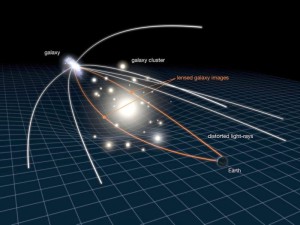Peter Lobner
In 2010, Prof. Erik Verlinde, University of Amsterdam, Delta Institute for Theoretical Physics, published the paper, “The Origin of Gravity and the Laws of Newton.” In this paper, the author concluded:
“The results of this paper suggest gravity arises as an entropic force, once space and time themselves have emerged. If the gravity and space time can indeed be explained as emergent phenomena, this should have important implications for many areas in which gravity plays a central role. It would be especially interesting to investigate the consequences for cosmology. For instance, the way redshifts arise from entropy gradients could lead to many new insights.
The derivation of the Einstein equations presented in this paper is analogous to previous works, in particular [the 1995 paper by T. Jacobson, ‘Thermodynamics of space-time: The Einstein equation of state.’]. Also other authors have proposed that gravity has an entropic or thermodynamic origin, see for instance [the paper by T. Padmanabhan, ‘Thermodynamical Aspects of Gravity: New insights.’]. But we have added an important element that is new. Instead of only focusing on the equations that govern the gravitational field, we uncovered what is the origin of force and inertia in a context in which space is emerging. We identified a cause, a mechanism, for gravity. It is driven by differences in entropy, in whatever way defined, and a consequence of the statistical averaged random dynamics at the microscopic level. The reason why gravity has to keep track of energies as well as entropy differences is now clear. It has to, because this is what causes motion!”
You can download Prof. Verlinde’s 2010 paper at the following link:
https://arxiv.org/pdf/1001.0785.pdf
On 8 November 2016, Delta Institute announced that Prof. Verlinde had published a new research paper, “Emergent Gravity and the Dark Universe,” expanding on his previous work. You can read this announcement and see a short video by Prof. Verlinde on the Delta Institute website at the following link:
You can download this new paper at the following link:
https://arxiv.org/abs/1611.02269
I found it helpful to start with Section 8, Discussion and Outlook, which is the closest you will find to a layman’s description of the theory.
On the Physics.org website, a short 8 November 2016 article, “New Theory of Gravity Might Explain Dark Matter,” provides a good synopsis of Verlinde’s emergent gravity theory:
“According to Verlinde, gravity is not a fundamental force of nature, but an emergent phenomenon. In the same way that temperature arises from the movement of microscopic particles, gravity emerges from the changes of fundamental bits of information, stored in the very structure of spacetime……
According to Erik Verlinde, there is no need to add a mysterious dark matter particle to the theory……Verlinde shows how his theory of gravity accurately predicts the velocities by which the stars rotate around the center of the Milky Way, as well as the motion of stars inside other galaxies.
One of the ingredients in Verlinde’s theory is an adaptation of the holographic principle, introduced by his tutor Gerard ‘t Hooft (Nobel Prize 1999, Utrecht University) and Leonard Susskind (Stanford University). According to the holographic principle, all the information in the entire universe can be described on a giant imaginary sphere around it. Verlinde now shows that this idea is not quite correct—part of the information in our universe is contained in space itself.
This extra information is required to describe that other dark component of the universe: Dark energy, which is believed to be responsible for the accelerated expansion of the universe. Investigating the effects of this additional information on ordinary matter, Verlinde comes to a stunning conclusion. Whereas ordinary gravity can be encoded using the information on the imaginary sphere around the universe, as he showed in his 2010 work, the result of the additional information in the bulk of space is a force that nicely matches that attributed to dark matter.”
Read the full Physics.org article at the following link:
http://phys.org/news/2016-11-theory-gravity-dark.html#jCp
On 12 December 2016, a team from Leiden Observatory in The Netherlands reported favorable results of the first test of the emergent gravity theory. Their paper, “First Test of Verlinde’s Theory of Emergent Gravity Using Weak Gravitational Lensing Measurements,” was published in the Monthly Notices of the Royal Astronomical Society. The complete paper is available at the following link:
http://mnras.oxfordjournals.org/content/early/2016/12/09/mnras.stw3192
An example of a gravitational lens is shown in the following diagram.
As seen from the Earth, the light from the galaxy at the left is bent by the gravitational forces of the galactic cluster in the center, much like light passing though an optical lens.
The Leiden Observatory authors reported:
“We find that the prediction from EG, despite requiring no free parameters, is in good agreement with the observed galaxy-galaxy lensing profiles in four different stellar mass bins. Although this performance is remarkable, this study is only a first step. Further advancements on both the theoretical framework and observational tests of EG are needed before it can be considered a fully developed and solidly tested theory.”
These are exciting times! As noted in the Physics.org article, “We might be standing on the brink of a new scientific revolution that will radically change our views on the very nature of space, time and gravity.”
